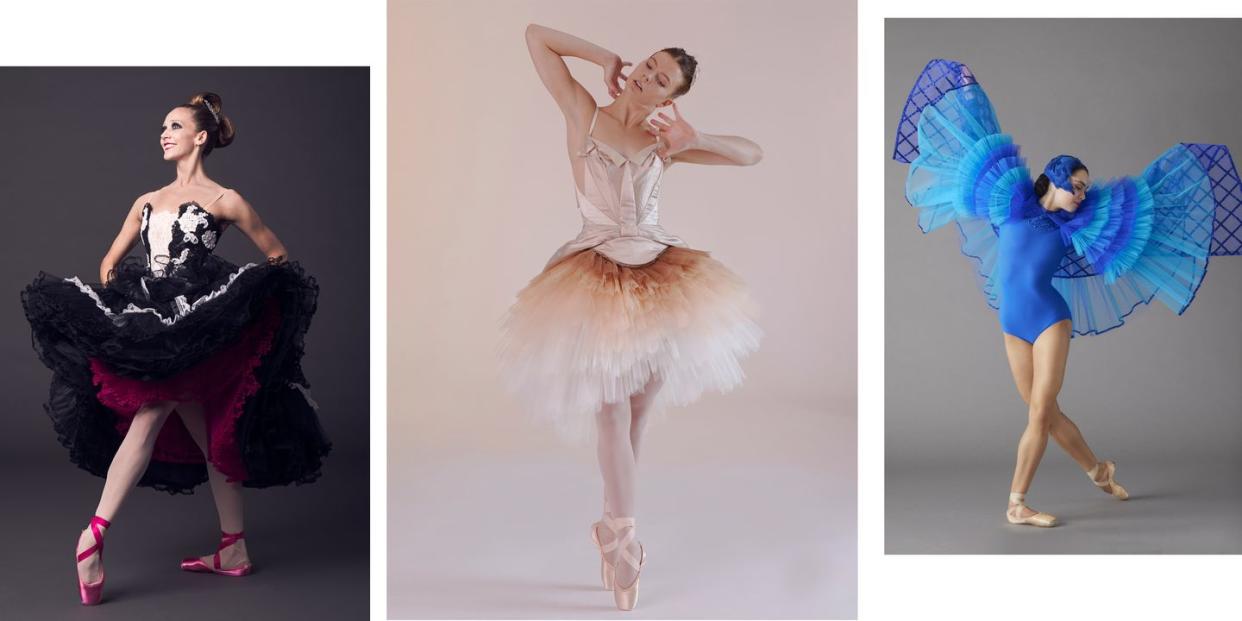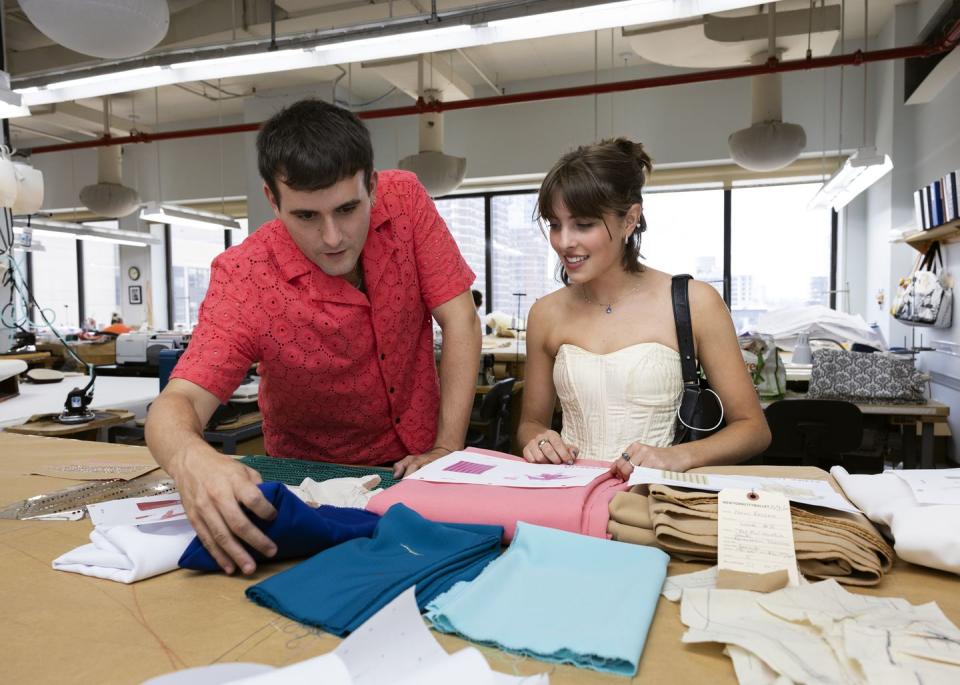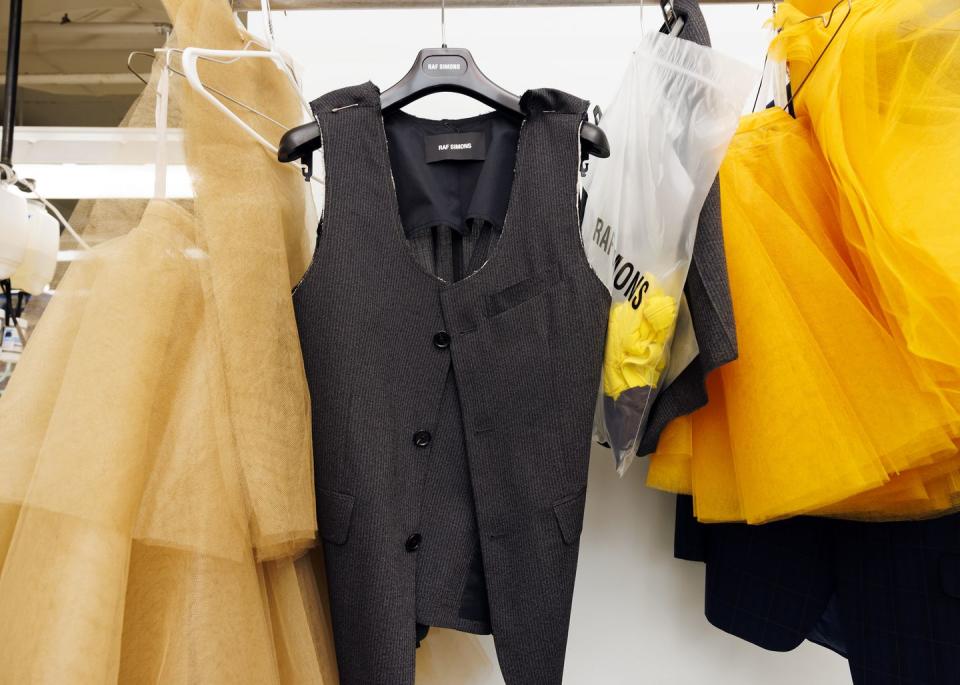Ten Years of Designer Tutus at New York City Ballet’s Fall Fashion Gala

Over the past ten years, the New York City Ballet costume shop led by NYCB Director of Costumes Marc Happel has collaborated with some of fashion’s biggest names and brightest emerging talents on wardrobe for the company’s annual Fall Fashion Gala. Tonight, Raf Simons and Paloma Spain founder Alejandro Gómez Palomo join an illustrious roster of 30 thirty designers that includes Valentino Garavani, Dries Van Noten, Sarah Burton, Carolina Herrera, Virgil Abloh, Christopher John Rogers, and Iris Van Herpen. Simons worked on the live performance premiere of NYCB Resident Choreographer Justin Peck’s Solo, and Palomo joined forces with choreographer Gianna Reisen on a world premiere set to an original score by Solange. Giles Deacon, who previously partnered with choreographer Kyle Abraham for the 2018 gala, is returning for an an encore collaboration for a new Abraham world premiere.
This year’s 10th anniversary celebration will honor Sarah Jessica Parker, a vice chair of the NYCB Board of Directors, who conceived the Fall Fashion Gala in 2012 and has led annual gala fundraising efforts that have raised more than $24 million for NYCB over the past decade. Ahead of the gala performance, Bazaar.com spoke with Happel about how to embellish costumes with 800,000 Swarovski crystals, design calls from Valentino’s yacht, and what fashion and dance can teach other.
Ten galas, thirty designer collaborations—I’m sure it’s hard to choose, but are there any that stand out in your mind as particularly successful or that you especially enjoyed?
Marc Happel: Of course I have to say that beginning with Mr. Valentino was a highlight I really treasure those moments with him because he is and always will be a fashion icon. When he was here in town, he would always make himself available. He would show up in the costume shop with Giancarlo [Giammetti] about noon or so. Dressed to the nines, and smelled amazing. He would come and basically hold court in the fitting room.
Other times, he would call me from his yacht in the Mediterranean, which he loved to refer to as a boat until I finally said I’d seen pictures of it and, in fact, it was a yacht. He would call me just with little details, like something should be ruched rather than pleated. Then he would tell me how hot the deck was and that the puppies’ paws were burning.
Beyond that, it’s hard for me to say, because they’ve all been amazing in some way or another. Mrs. Herrera introduced me to having beadwork done in India, and I love Dries Van Noten’s use of color and pattern, how he mixes them. Certainly there are some designers that were more hands on than others.
Thom Browne was just another delight to work with. I think he took a special interest in challenging the shop in any way he could. At one point he wanted me to outline all the pleats of the skirts with grosgrain ribbon. He showed me a sample that his studio had done and said, ‘Can you see if you could do this?’ He came in two days later and we had a skirt completely done. He was kind of like, ‘Oh, okay, well since you’ve done that, now how about this?’ He always had little challenges for us and we always met them. I think he was pleasantly surprised by what we could produce.
How have you found collaborating with designers who aren’t necessarily used to designing for the stage?
MH: There are three things I always talk to them about right away. One is scale and detail and how it gets lost with distance on stage, as opposed to a runway or red carpet. Many times I will put something on a dress form and have them stand at the opposite end of a long hallway and say, ‘You are row A. Everyone else is farther away.’ I want them to realize that the little details are going to get lost.
The next is stage lights and how harsh they are and how much they can change color. Many times subtle colors get bleached out and you have to push everything a little bit to make sure that it reads.
Then the third thing is using fabrics with stretch in them. These days there are so many great stretch fabrics that have been developed so that if a designer comes to me and wants to do everything in chiffon, I will say, ‘Well what about stretch chiffon?’ Or if they want organza, ‘What about stretch organza?’ That’s been very interesting because sometimes I get designers that don’t realize that there are these stretch fabrics, and I see that they then take it back to their studios and play with in their own fashion making.
Some of the costumes are obviously much more streamlined—more like traditional leotards and tutus—and some of them are really out there. What are your conversations like around what shapes work for dance? I'm thinking of Christopher John Rogers, for example, with those huge volumes that are very different from what we usually see in ballet. I imagine what Alejandro Gómez Palomo is cooking up for this year’s gala will be really something.
MH: Sidra Bell, the choreographer who worked with Christopher John Rogers specifically requested volume. She was interested in working with these very large, graphic, colorful shapes. She choreographed around that in a way.
It’s the same with choreographer Gianna Reisen and Alejandro Gómez Palomo. It’s quite outrageous what he’s cooked up: the costumes are covered in about 800,000 Swarovski crystals! She’s very much embraced what his concept is and worked around it. When the dancers get into a fitting room, initially they feel the weight. But then I think that once it’s on them, they see how spectacular it is.

Did all those crystals have to be hand applied?
MH: No, no. Swarovski very generously supplied us with sheets of crystals, these 36” x 18” plastic films. You lay that onto the pattern pieces, and then with a large hot fix machine—it’s basically a big heat press—the crystals adhere in a striped design.
I imagine Iris Van Herpen would have been another designer with quite an innovative approach?
MH: That was a time when I really felt like costume making moved into the 21st century, because we realized in doing her costumes that they were shapes that all reflected the musculature of the body in some way. Each comprised maybe 25 to 50 different half moon shapes in graduating sizes . We realized in the beginning that it was going to take forever for us to pattern this. At the time, her husband worked for an architecture company and she took a layout home. He said, ‘Well, this is something he could do on the computer.’ We basically had him create files for us that were printouts of the patterns so that then we could use those to cut these shapes out. It was a huge help and probably saved us months of work.
Are there any collaborations that you weren’t initially sure about?
MH: Zac Posen had this idea that he wanted to take old costumes and turn them upside down. He asked me for several old tutus, and in the beginning it was like, ‘Oh, I don’t know if this is going to happen.’ Then, doing a little digging, I found some old Symphony in C costumes. Old, discarded tutus that were in pretty bad shape and shouldn’t really be seen on stage anymore. I sent them to him and he took them and did amazing things with them. He turned them inside out, he turned them upside down, he cut skirts off and put them back on in different places.

What is the process like for choosing the choreographer-designer pairings?
MH: Usually what happens is that we come up with a list of fashion designers that we feel might be interested. Many times we’ll come up with five or six. Some years it’s been as many as 10 or 12. I present them to the choreographers and get their favorites. Then Sarah Jessica Parker reaches out to the designers and makes the official ask. For the most part over the years, they’ve said yes. I can’t think of too many that have declined the invitation.
Does the designer start sketching costume at the same time as the choreographer begins choreographing?
MH: We try to have that happen, as much as we can. It’s always a little bit of the cart before the horse, because we start on the costumes in late spring and many times at that point, the music isn’t even chosen. At the beginning of Gianna concepting her piece for this year’s gala, there was no Solange.
Often he three of us sit together—the choreographer, designer, and myself— and we talk about what they’re thinking about, if they’ve got any ideas or concepts whatsoever, even a remote idea, so that at least the designer can begin. Often I’ve found that the designs can really inform the choreography, and that’s very different than it usually is in ballet.
This season you’re also collaborating with Raf Simons as well as Giles Deacon, who you’ve worked with before. What are their concepts?
MH: Raf, I didn’t meet at all. He had conversations with Justin and then sent the finished costumes, which is the first for us. They are overscaled men’s tailored garments and they had an atelier somewhere in Italy, I think, or Paris, make them. It’s just a single dancer in the piece; Anthony Huxley will perform at the gala and then Sara Mearns takes the role later in the season.

This is Giles’s second time designing costumes for a Kyle Abraham ballet for the gala. He sends me prints. This time, he sent three of them and we had them printed on about five different fabrics. Those are incorporated into making costumes that have historical references that are somewhat all mixed up and come together in a very unique way. Giles riffs on a lot of Renaissance silhouettes—pumpkin hose, very full shirts, that kind of thing—and there are classical tutus as well. The silhouettes are kind of unified by the prints.
What’s the most important element of ensuring a collaboration’s success?
MH: We have an amazing group of artisans here in the New York City Ballet costume shop who always make themselves 100% available to create these costumes. They’re often dealing with very unusual techniques, and they always rise to the occasion. This gala wouldn’t happen without them.
You Might Also Like

